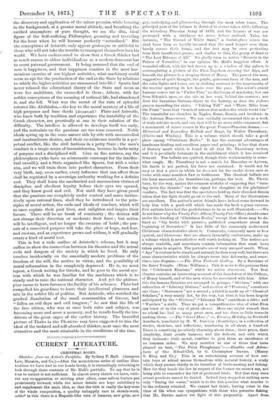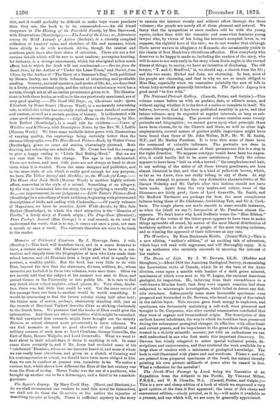CURRENT LITERATURE.
CHRISTMAS ROOKS.
Sketches from an Artist's Portfolio. By Sydney P. Hall. (Sampson Low, Marston, and Co.)--After the monotonous series of outline illus- trations wo have had in our bands lately, it is exceedingly refreshing to look through these contents of Mr. Hall's portfolio. To say that he is true to nature is not sufficient. In almost every sketch we have, with- out any exaggeration or striving after effect, some salient feature put prominently forward, while the minor details are kept subsidiary to and supplement the main idea, so that the title is really the key-note of the whole composition, a quality unhappily rare in sketch-work. Added to this there is a Hogarth-like vein of humour, now grim, now gay, underlying and glimmering through the most sober tones. The principal part of the volume is devoted to scenes taken while following the victorious Prussian Army of 1870, and the horrors of war are portrayed with a vividness wo never before realised. Take, for instance, The Shroud of White Sand," a burial-place where the dead have been so hastily interred that the sand heaped over them barely covers their forms, and the foot may be soon protruding from their insufficient grave ; and similar to this, the group of dead in "The Last Bivouac of All." Wo gladly turn to notice "Reverie in the Palace of Versailles," in our opinion Mr. Hall's happiest effort. A wounded officer, with his bed drawn up to a window of the palace, is contemplating a piCture of the First Napoleon crossing the Alps, and beneath the picture is a sleeping Sister of Mercy. The pose of the MUM, suggestive of quiet thought, the gentle, quiescent form of the nun, and the calm lights and tones, are in striking contrast to the impetuosity of the warrior spurring in hot baste over the pass. The artist's genial humour comes out in "Under Fire," no discharge of musketry, but one from Sidonie's eyes, as she sits at her work behind the counter ; nor does the luxurious German object to the battery, as does the jealous garcon ascending the stairs. "Taking Toll" and "Three Miles from the Front" have that "touch of nature that makes the whole world kin." Tho remainder are sketches in Naples, Rome, Russia, and incidents in the Autumn Manoeuvres. Wo can cordially recommend this as a work of truly artistic merit, and one that will bo no more table-ornament, but a monument of minor scones in the great Franco-Prussian drama.— Historical and Legendary Ballads and Songs, by Walter Thornbury. (Chatto and Windus.) This is a volume which should take a good place among "Christmas Books." It has the external advantages of handsome binding and excellent paper and printing; it has that share of literary merit which is found in all that Mr. Thornbury writes, and it is peculiarly fortunate in the enrichment which it has received from art. The ballads are spirited, though their workmanship is some- what rough. Mr. Thornbury is not a match for Macaulay or Aytoun, his finish is not perfect, his force not sustained. It would not be easy to find a piece in which he does not lot the reader down once or twice with some manifest flaw or feebleness. The classical ballads are the least successful, the Scandinavian, perhaps, the best. Mr. Thorn- bury, by the way, makes the common mistake of supposing that " turn- ing down the thumbs" was the signal for slaughter in the gladiators' combats. The fact was that the spectators held up their clenched Retain token that the fight should go on to the end. Many of tho illustrations are excellent. The author's artist friends have indeed come forward to help him with a good-will which has made the book a great success. Few authors have had the good-fortune to be so well illustrated.—We do not know why the Vanity Fair Album(Vanity Fair Office) should come under tho beading of "Christmas Books," except that these may bo de- fined as "big books with pictures, published somewhere about the beginning of December." It has little of the commonly understood Christmas characteristics about it. Comments, commonly more or less cynical, and likenesses that are almost invariably caricatures, make up a volume which is nevertheless well worth looking at. The notices are always readable, and sometimes contain information that must have taken pains to acquire. The portraits are of very unequal merit. When " Apo " is content to be simple and natural, he does very well, but there are some characteristics which he always turns into deformity, and some- times into disguise.—The Eton Portrait Gallery. By a Barrister of the Inner Temple. (Eton : Williams.) This is more to the purpose than the "Celebrated Etonians" which wo notice elsewhere. The first chapter contains an interesting account of the foundation of the College, of Henry himself, and of the mon whom ho associated with him. After this the famous Etonians are arranged in groups ; "Divines," with one subsection of " Literary Divines." and another of "Provosts," constitute one class ; " Statesmen " are a second ; a third is made up of " Classical Scholars," a very scanty list, by the way, but then it has been largely anticipated by the " Divines ;" " Literary Men" contribute a fifth ; and " Warriors " a sixth. Thus we got a comprehensive idea of what Eton can boast of in the way of great alumni. Hero one might remark that no school has had so many great mon, and has done so little towards making them. —The " Good Hour ;" or, Evening Holiday, by Berthold Auerbach, translated by H. W. Dulckon (Routledge), is a collection of stories, sketches, and reflections, numbering in all about a hundred There is something peculiarly charming about them ; their grace, their simplicity, their gentle humour, and the delicate tact with which they insinuate their moral, combine to give them an excellences of no common order. We may mention as one of those that have pleased us best, "The Prize Ploughman."—Rantides and Adven- tures of Our School-Club, by G. Christopher Davies. (Henry S. King and Co.) This is an entertaining account of how cer- tain boys at school amuse themselves with natural history, a study which they pursue chiefly in its branches of birds-nesting and fishing. How far they break the law in respect of the former we cannot say, not being able to remember the list of protected birds. But that they were arrant poachers cannot be denied. Indeed they stopped at nothing save only "liming the water," which is to the fish-poacher what murder is to the ordinary criminal. We cannot but think, having come to the time of life when one sympathises with those who preserve fishing that Mr. Davies makes too light of this propensity. Apart from this, and it would probably be difficult to make boys worse poachers than they are, the book is to be commended.—An old friend reappears in The History of the Fairchild Family, by Mrs. Sherwood, with Illustrations (Routledge).— The Land of the Lion; or, Adventures among the Wild Animals of Africa (Seeleys), is a cleverly compiled collection of hunters' tales, and sketches of life and manners, which have chiefly to do with northern Africa, though the central and southern parts have also their share of attention. There are not a few curious details which will be new to most readers; porcupine-hunting, for instance, is a strange amusement, which the aboriginal tribes much affect, but to which the Arab will not condescend.=—Stories from the South Seas, by the Author of "Under the Lime-Trees," and Stories from China, by the Author of " The Story of a Summer's Day," both published by Messrs. Seeley, are both little volumes of interesting and profitable reading. Scenery, national manners, and modes of life, &c., are described in a lively, conversational style, and the subject of missionary work has a certain, though not at all an undue prominence given to it. The illustra- tions in both these books, as well as in the one previously mentioned, are of very good quality.—The Good Old Days; or, Christmas under Queen Elizabeth. by Esmd Stuart (Marcus Ward), is a moderately interesting tale, in which the writer has carefully worked up some details of costume and custom, as woll as a certain portion of history. It is illustrated with some good chromo-lithographs.—Lily's Home in the Country, by Mrs. Sale Barker (Routledge), is a small tale for children.— Views of Wicklow and Killarney, with Descriptive Notes, by the Rev. W. I. Loftie (Marcus Ward.) Wo have some readable letter-press with illustrations of varying quality, the engravings being certainly better than the chromolithographs.—The Blue-Beard Picture-Book, by Walter Crane (Routledge), gives us some old stories, charmingly pictured, Both drawing and colouring are admirable. Mr. Crane has had the courage to give a happy ending to "Little Red Riding-Hood." Bat we are not sure that we like the change. The age is too soft-hearted. There are wolves, and men with guns are not always at hand to shoot them when it is wanted. From the same designer and publisher, and in the same style of art, which is really good enough for any purpose, we have The Yellow Dwarf and Aladdin ; or, the Wonderful Lamp.— The House that Jack Built (Marcus Ward) is another highly artistic effort, somewhat in the style of a missal. Something of an allegory, by the way, is insinuated into the story, the rat typifying a rascally son, &c.,—no improvement, in our judgment—Little Tottie's Picture-Book (Routledge) is a miscellany of truth and fancy, beginning with pictures and descriptions of birds, and ending with Cinderella.—Of yearly volumes of Magazines, we have to mention Little Wide-Awake, by Mrs. Sale Barker (Routledge), in which the chief attraction is the "Memoirs of Poodle," a lively story of French origin ; The Peep-Show (Strahan); Peter Parley's Annual (Ben George) is a real annual, as we used to understand the word ; that is to say, it comes out once a year, not once a month or once a week. The contents therefore are sure to be fresh to the reader.







































 Previous page
Previous page